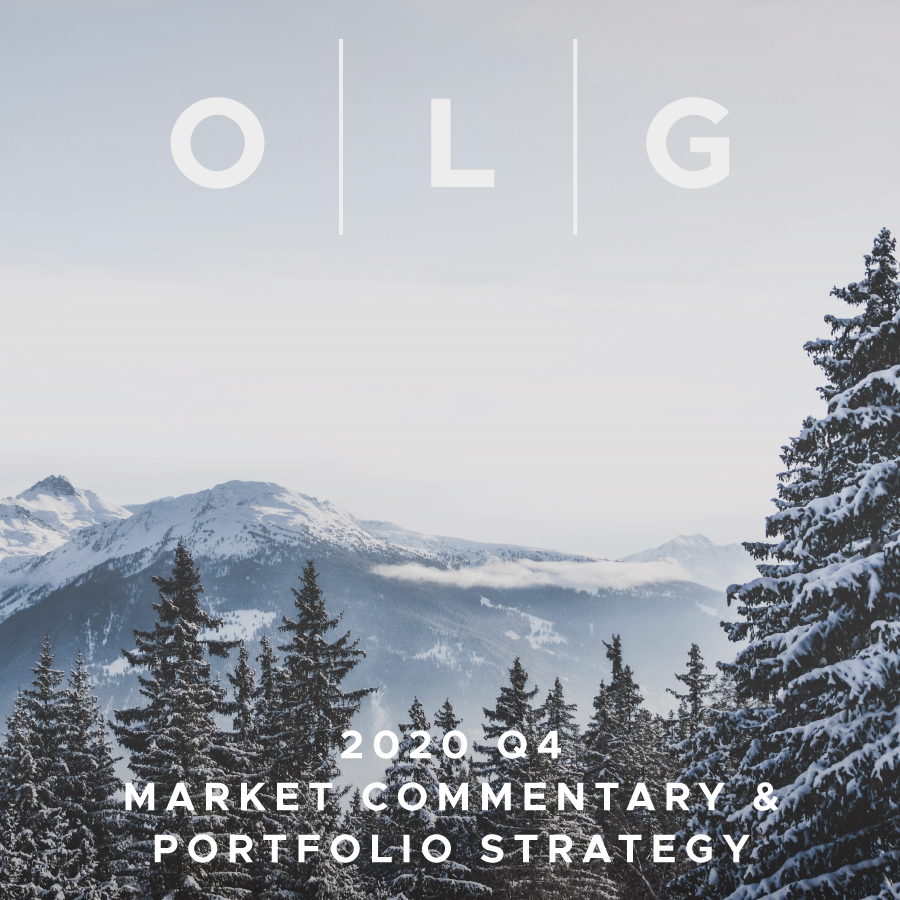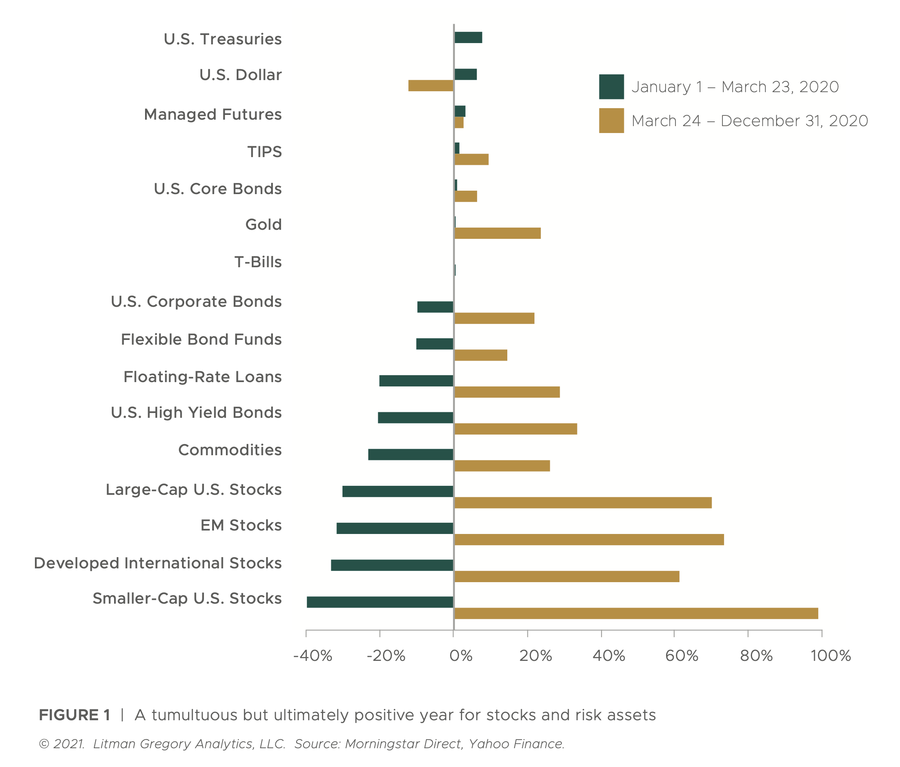
Fourth Quarter Investment Commentary
2020 Q4 Edition
In our first quarter 2020 letter back in April, which feels like an eternity ago, we recognized that we were living through an incredible period of history. The pandemic weighed heavily on us then, as it does today. But this quarter, we look back at what we’ve endured and lay out our investment outlook for 2021 and beyond. While many risks remain, the effective vaccines that are starting to be distributed provide a real light at the end of the tunnel.
We said in the first quarter that we would get through this crisis and that things would improve and recover. Financial markets recovered first, experiencing both their quickest decline and rebound on record, despite the significant global economic contraction. Economies have made great progress too but are not back to their pre-COVID-19 levels yet and may not be
for another year or two. On the health side, despite the approval of several effective vaccines, the authorities warn us that we may be in for dark days this winter before they can be widely distributed to the general populace. This may set back economies and markets in the near term and keep us isolated and sheltering in place in some cases. But we expect that 2021 will see the end of the pandemic and our society can then follow markets and the economy in bouncing back as well.
In the meantime, our wish remains the same as it was in April: that you and your loved ones stay safe and healthy.
Market Recap
This year was a hard one. Yet global stocks were up 16.3% for the year. U.S. stocks did a bit better, with large caps up 18.2% and small caps up 20.0%. Developed international stocks gained almost 10% and emerging-market stocks gained over 15%.
The comforting full-year returns mask the incredible volatility and stress investors faced earlier in the year. Stock markets around the world were down 30%–40% for the year by March 23, the year’s low point. From there, stocks skyrocketed into year-end. Amazingly, the major large- cap indexes are all up over 65% from their lows; smaller-cap U.S. stocks have nearly doubled since then. During the worst days of March, with pandemic fears rampant and the global economy falling off a cliff, very few predicted this year’s outsized performance for stocks.
Moving on to fixed-income, core investment-grade bonds gained a strong 7.6% for the year, providing positive returns both during and after the market crisis period. In typical fashion, early on in the year Treasuries and high-quality corporate bonds benefited from falling rates amidst a deflationary shock. Interest rates have risen modestly since the positive vaccine news in November, but they are still generally much lower than they were at the start of 2020.
In the lower-quality sectors of the bond market, high-yield bonds and floating-rate loans posted 6.2% and 3.1% gains, respectively, for the year. Both asset classes materially outperformed core bonds during the last three quarters of the year. But they still have some ground to make up from the tremendous selloff they suffered in March before the Federal Reserve stepped in to support the financial markets with bond-buying and other liquidity- supporting programs.
Portfolio Update
In a challenging and chaotic year, our client portfolios performed well. The first quarter was difficult. But our decision in early April to add an increment back to U.S. stocks added value,
as stocks have strongly recovered. The S&P 500 is up roughly 50% from that trade date. We faced the same uncertainties as any other investment manager at the time. But while we did not foresee the market would rebound so far so quickly, we were confident that equity valuations had become more attractive, that expected returns had increased, and that it usually pays to be greedy when others are fearful.
Broadly speaking, since May, our active portfolios have been beating their benchmarks. We are optimistic that recent portfolio performance is the beginning of a more sustained trend. As we discuss below, there is good reason to believe prior years’ macro and market headwinds may be turning into tailwinds for our portfolio positioning.
Looking Ahead to 2021 & Beyond
The vaccines, easy financial conditions, and stimulative fiscal policy are all reasons for our optimism looking ahead. The likelihood of widespread vaccine distribution supports the case for a cyclical economic recovery beginning in the second and third quarter of 2021. Central bank monetary policy is almost certain to remain very accommodative for at least the next year or two. And fiscal policy is unlikely to be restrictive. This macro backdrop should be supportive of equities and other financial risk assets, at least for the next year.
U.S. stocks have high absolute valuations. Expected five-year annual returns in our base-case scenario are still only in the low single digits. But U.S. stocks don’t look expensive relative to extremely low bond yields. Our research team is in the process of updating key assumptions in our base-case analysis of U.S. equity expected returns. Based on our preliminary work, we don’t expect to change our current portfolio positioning as a result. However, our updated analysis will impact the S&P 500 trigger levels at which we would add U.S. equity exposure in a future market selloff or reduce exposure if valuations sharply expand.
In our view, non-U.S. stock markets, emerging-market stocks in particular, are more attractively valued and have much higher five-year expected returns than U.S. stocks. We remain underweight to U.S. stocks and overweight to emerging-market stocks for this reason. It’s important to repeat that the plausible argument that low interest rates justify higher U.S. stock valuations is only more applicable overseas where stocks are even cheaper compared to bonds, which sport negative yields in some places.
Currency is another potential tailwind for non-U.S. stocks over U.S. stocks. If the aforementioned global economic recovery and extension of accommodative monetary policy plays out, we’d expect the U.S. dollar to continue its recent decline. As a “counter-cyclical” currency, the U.S. dollar tends to move in the opposite direction of global growth. If the dollar declines, U.S. investors in non-U.S. stocks will earn a currency return on top of any equity return.
We recognize our base case for a cyclical recovery and market returns for 2021 now seems to be the consensus view. While the consensus view is often wrong, we’d be happy to see our formerly contrarian views, particularly our favoring of non-U.S. stocks over U.S. stocks, become the consensus next year.

The Risks to Our Outlook
As always, there are numerous risks to our economic/market base case. Unexpected shocks can happen at any time, whether a jump in inflation, domestic political dysfunction, geopolitical conflict, or trade dispute. Financial market history teaches us to expect the unexpected and expect to be surprised.
Over the next few months, there is a real risk of a sharp economic slowdown from pandemic- induced lockdowns and, potentially, inadequate additional fiscal relief for households, small businesses, and state and local government budgets. The current extreme investor optimism also leaves the market vulnerable to disappointment. But given the positive macro and investment backdrop, we would likely view any financial market drawdowns as temporary.
Looking out longer term over our five-year tactical horizon, the big risks we are watching are the specter of inflation and China.
Inflation is a lower concern at this point, but the risk isn’t zero. Rising demand stemming from spending unleashed after the pandemic could coincide with a supply side constrained by the retreat of globalization to instigate an inflationary spiral. Clients should know that we have several asset classes and strategies in our portfolios—flexible bond strategies, floating- rate loans, alternative asset classes, and global stocks—that should do well in an inflationary environment. We also have other inflation-sensitive investment options at our disposal should we see the need for additional tactical protection.
Turning to China, we are focused on the risk and opportunity it presents because of its outsized influence within the emerging markets. China has handled the pandemic relatively well, but its stock market has also been one of the best-performing ones in 2020. We wouldn’t be surprised to see stocks there pullback, especially as China reins in excesses and reduces stimulus (after all, according to the International Monetary Fund, China is the only country expected to have generated positive GDP growth in 2020). We also expect trade and tech conflicts to continue. But longer term, we remain bullish on China and emerging-market stocks in general. Our fundamental assumptions are quite conservative in our opinion, offering plenty of room for emerging markets to surprise on the upside. We think we are in the early stages of investors rebalancing their portfolios to increase non-U.S. equity exposure, especially emerging-market stocks (so demand is rising) and recent capital flows data confirm this. The trade war and the potential reversal of globalization have only underlined the importance of global diversification for equity investors.
Closing Thoughts
Our portfolios are well positioned for the base-case cyclical recovery from the global pandemic, but our positioning always incorporates a wide range of potentialities. We think in terms of multiple plausible scenarios, not in point estimates and dramatic binary bets. Should a less sanguine outcome occur, we have investments in the portfolio that can offer downside protection. And we are prepared to prudently, but opportunistically, respond as events unfold as we did in 2020.
The market has always exhibited dramatic mood swings, whipsawing investor sentiment, and 2020 was no different. We recommend investors ignore the crowd’s actions completely and, as we closed our first quarter letter, “stay the course.” While it’s a cliché in the investment business, that advice proved prescient this past year.
Better yet, be prepared to take advantage of the market’s mood swings, as we did this past year to our clients’ benefit. We reallocated capital to stocks near the depths of fear in March and it rewarded our clients handsomely. We’ve seen countless studies of unguided investors selling their stock exposure near the market bottom, then reinvesting as markets stabilized or fully recovered—the investor sentiment “whipsaw” effect that we often warn about. Instead, one should be greedy when others are fearful. Our disciplined approach allowed us to do this successfully in 2020 on your behalf. We thank you for your continued trust in us.
Here’s to saying goodbye to an unfortunate year we are all eager to leave behind and to welcoming a hopefully brighter 2021. We wish everyone a healthy, happy, and prosperous year to come.
— Owen Legacy Group
The Market Commentary & Portfolio Strategy is mailed quarterly to our clients and friends to share some of our more interesting views. Certain material in this work is proprietary to and copyrighted by Litman/Gregory Analytics and is used by Owen Legacy Group with permission. Reproduction or distribution of this material is prohibited and all rights are reserved.